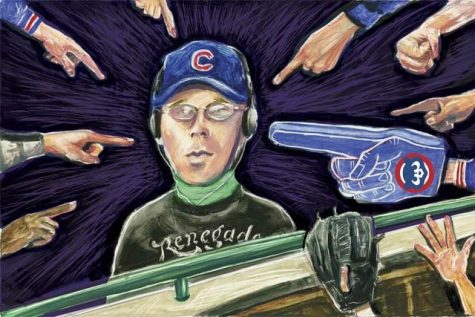They did it! (The history and power of the scapegoat)
March 21, 2017
It’s the top of the eighth and the Cubs are up 3-0 on the Marlins in Game 6 of the NLCS in the year 2003. WHAM; Marlins second baseman Luis Castillo crushes a heater thrown by Cubs pitcher Mark Prior. The sound rippled through Wrigley Field like a sonic boom. Every fan in Wrigley was focused on the flying ball as it soared toward the bleachers in left. Left Fielder Moisés Alou ran and leaped at the wall when unexpectedly, fan Steve Bartman, stretched out his arms and deflected the ball preventing Alou from making the catch. The Marlins scored eight straight runs. The Marlins won Game 7. The Marlins advanced to the World Series. Fans were stunned and needed to find someone to blame for their terrible, crappy team’s performance. In the end, the finger was pointed in the direction of Bartman. When he deflected the ball, fans cited the curse and pointed the finger at him and deemed him responsible for the Cubs giving up eight straight runs and for losing Game 7.
This is a classic example of scapegoating. The term scapegoat comes from biblical times when locals would sacrifice a goat in the hopes that it would resolve all of their problems. The goat would be forced to “carry everyone’s guilt” to hell. In the case of Bartman, the fans felt that his minor mistake should be held responsible for the team blowing a two game lead. The incident drove Bartman into hiding and ruined his life.
Scapegoating is very popular in our society and tends to go unnoticed. Whenever we commit a mistake, we quickly look for the first person to blame it on and give little thought into what we are doing. When it comes to teenagers here at Portage Northern, our brains are underdeveloped causing us to make rash decisions that we don’t fully comprehend until giving it later thought. A common example of scapegoating for students would be if a student were to blame something or someone for not having his work done. For students, scapegoating is another term for excuse. When something doesn’t go their way, they quickly look for something or someone to point the finger at instead of owning up to their mistake. When I asked around Northern, it seemed as though most students understood the meaning of the word. My favorite definition came from Micah Graff (10) in which he said, “Scapegoating is blaming someone else who did nothing wrong.” It seems as though most students understand what the term means, but they don’t understand the impact it has. Human beings are selfish and will not hesitate to throw someone under the bus to protect themselves when they are being hung out to dry.
Scapegoating contains a lot of power and can quickly ends someone’s life for something that may not be entirely their fault. I challenge students here at Northern to rethink the way they act and behave and to take ownership in their mistakes and to understand the word “Empathy” and the power that it holds. We are human and we are bound to make mistakes, it is the way we handle ourselves after that will inevitably shape us into who we are and what we become in the future.
Artist portraying Scapegoating









